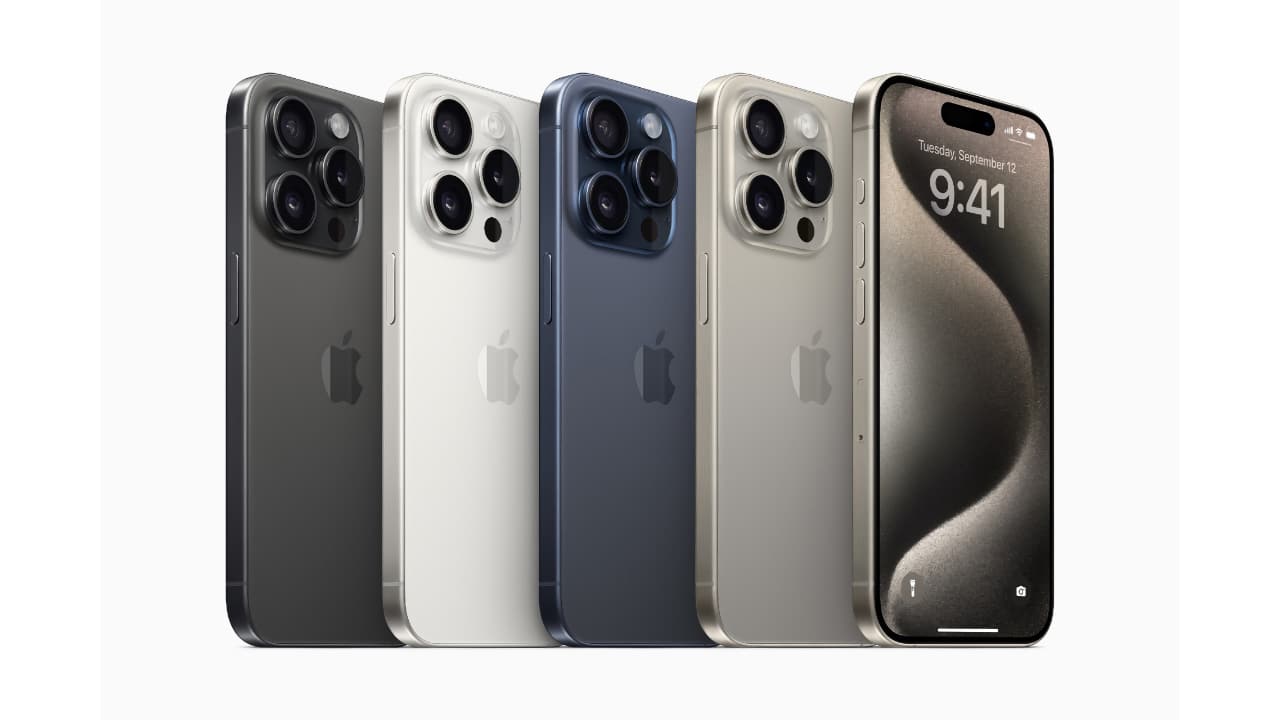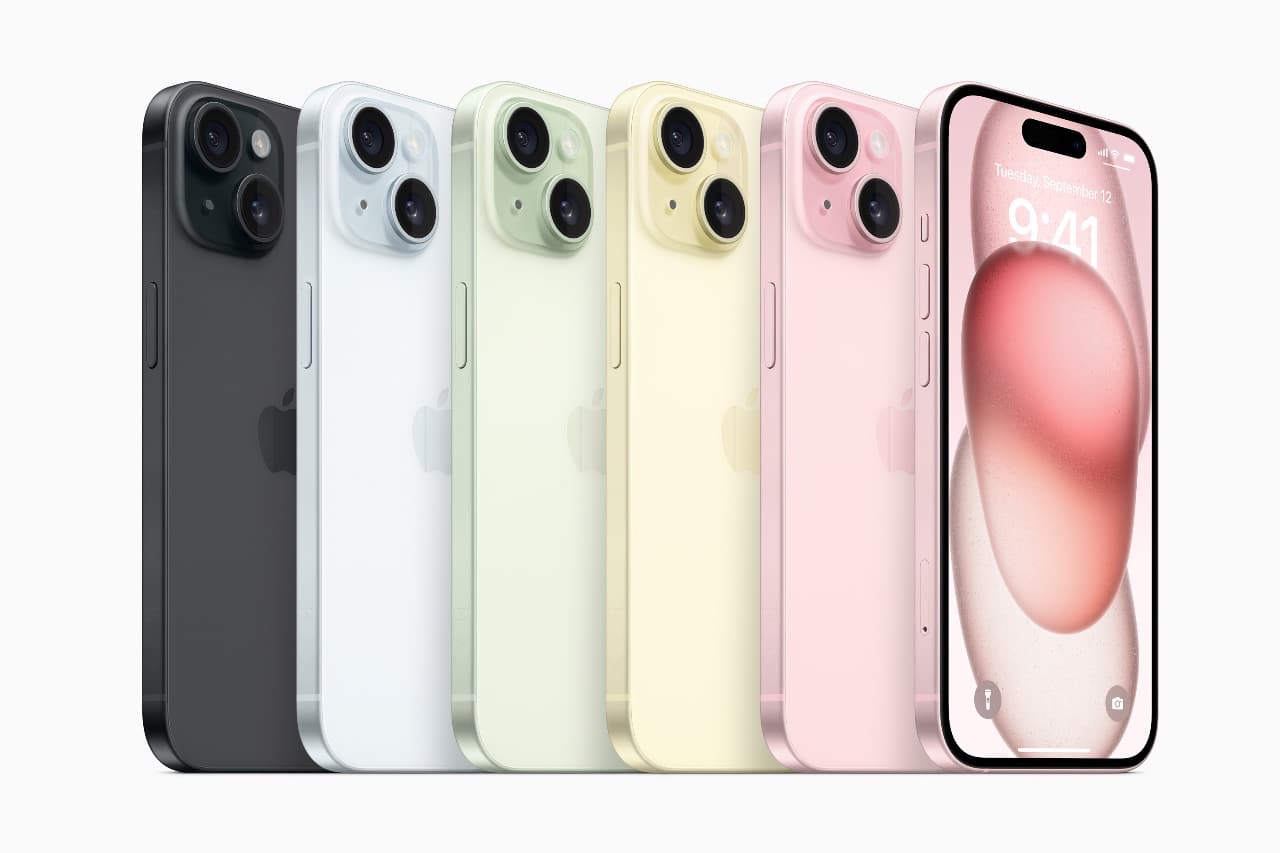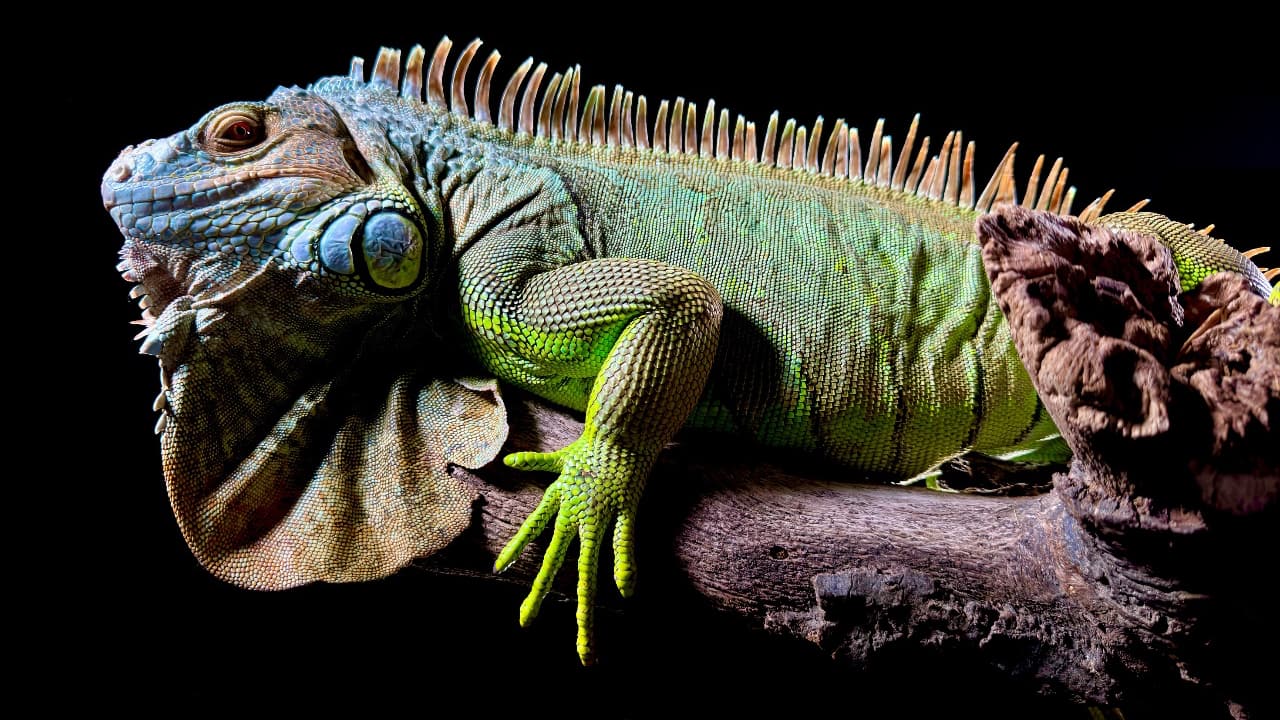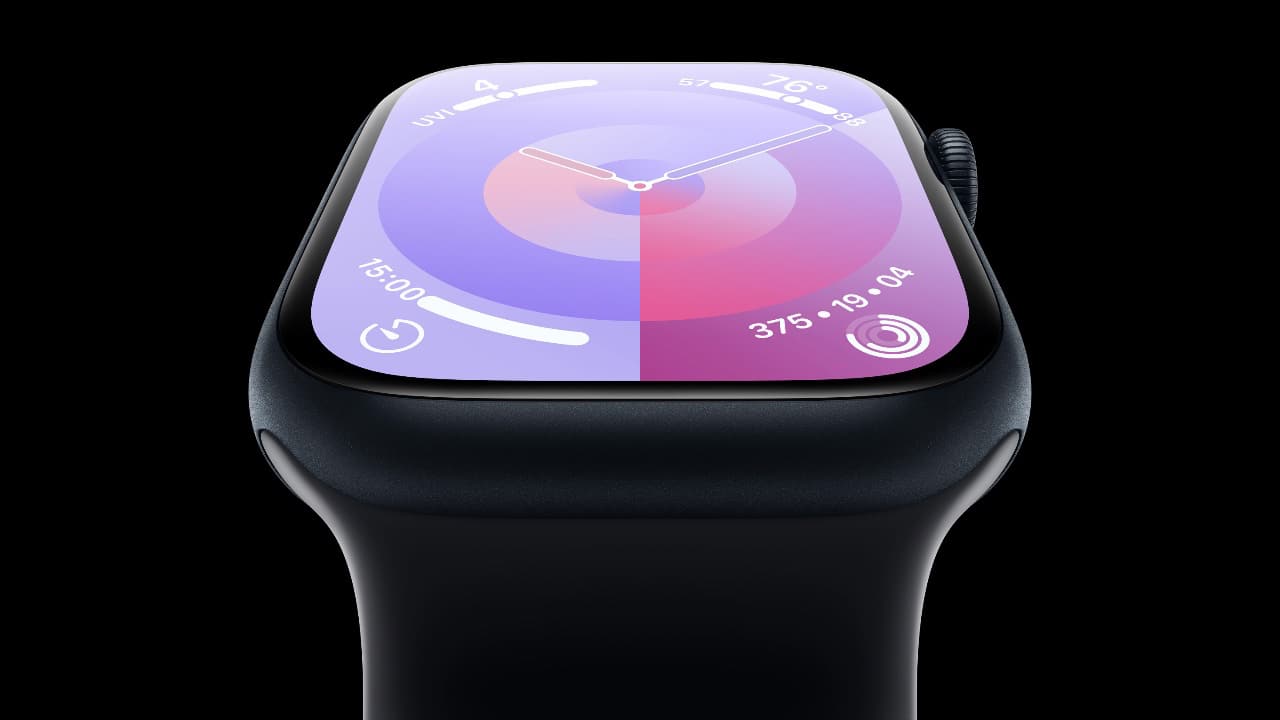
The new iPhone 15 Pro features the first 3nm smartphone chip, which powers some significant advances in photography, video, and gaming with USB-C as standard.
There is much to unpack from yesterday's Apple presentation, so without further ado...
iPhone 15 and 15 Plus

This year's colour palette...
While last year’s iPhone 14s lacked excitement compared to the Pro models, this year’s models are more interesting. Yes, the SoC is the A16 Bionic from last year’s Pro models and not the latest cutting-edge process, but last year’s Pro features were excellent, and we get many of them trickling down to the standard iPhone 15s.
The signature feature of the 14 Pro models was ‘Dynamic Island’ which takes the camera notch and turns it into an inventive animated window for notifications and alerts— live sports scores, updates on your flight and so on. Third-party support hasn’t been overwhelming, but this should improve by the Island becoming standard across the range.
More significantly, the main camera is now 48MP - the same as last year’s Pro and a big increase from the 12MP in the 14. The iPhone’s Photonic Engine will take the sensor’s output and provide a 24MP image as a default. A 2X telephoto option leverages that 48MP sensor to provide ‘optical quality’ 0.5x, 1x and 2x options.
All the 15 models also get ‘next generation portrait mode'. Suppose the camera senses a person or a pet. In that case, it will automatically capture enough depth information via its LIDAR sensor so you can convert a standard photo into portrait mode and choose focus and depth control to suit. One demo showed a portrait mode photo with the foreground person in focus and another in the background blurred; a few touches later and this was reversed.
The iPhone 15 chassis is aluminium, of course, but with more bevelled edges than the squared-off 14, while the back uses infused colour glass - rather than last year’s flat colours; this year’s more pastel colours appear to float in the glass. We also get the second generation Ultra Wideband chip, which improves FindMy performance and offers a 3x improvement over the previous gen. Another neat feature is using ML for better filtering out of background noise if making a call in a noisy environment.
At the EU’s behest, Lightning is no more, and instead we get USB-C with the A16 chip limiting transfer speeds to USB 2 speeds (480Mbs). USB-C AirPods, EarPods, etc., are all moving to USB-C, and one neat feature is that you can charge AirPods from your iPhone using a USB-C cable. There’s also a dongle to convert from USB-C to Lightning for your now-outmoded accessories.
Pricing starts at $799 for the 6.1-inch and $899 for the 6.7-inch Plus model, both starting at 128GB and going up to 512GB storage (interestingly, pricing is actually slightly cheaper than last year’s UK RRPs). Pre-orders begin on Friday, September 15, and availability is listed as a week later.
Satellite Services
All this year’s new iPhones get Emergency SOS, which debuted last year in the US and now expands to 14 additional countries, including the UK. There’s also a new Roadside Assistance service, initially in the US only, where the AAA will answer calls if you need help outside of normal cellular coverage. As with iPhone 14, Apple will provide satellite coverage for two years free of charge.
iPhone 15 Pro and 15 Pro Max

The 48MP camera in the 15 Pro Max is capable of some stunningly detailed images
The A17 Pro is Apple’s first A-Series chip with a Pro name, reflecting a significant leap in performance. Apple’s TSMC partnership has once again paid off with the world’s first smartphone chip on a 3nm process.
The process shrink allows for 17 billion transistors (rather than 16 billion before) and a six-core CPU featuring two high-performance cores with a 10% bump and 4-high efficiency cores that Apple claims offer 3x performance/watt compared to the competition - a meaningful difference with these cores taking the majority of the work. A 16-core neural engine is up to twice as fast as the A16.
A dedicated video and display controller adds hardware acceleration for the AV1 video codec promoted by Google, Microsoft, and Netflix as a royalty-free alternative to H.265. A new USB controller also supports 10Gbps USB 3 transfer speeds over USB-C.
The star of the show, however, is the GPU, a new design by Apple that, aside from 20% higher peak performance, offers a host of new features, including mesh shading support, Metal FX upscaling and hardware acceleration for ray tracing. Unsurprisingly, this provides the fastest RT performance of any smartphone and is 4X faster than software-based RT on the A16.
Given that the PS5 and Xbox Series X struggle to consistently employ ray-tracing during typical action scenes, the real-world implication for iPhone gaming is unclear. Overall, the A17 Pro offers a new era in mobile gaming, according to Apple.
To back up this claim, we saw a showreel of The Division: Resurgence (more realistic fire), Honkai Star Rail (more realistic waves) and, of course, an enhanced Genshin Impact. We’re also promised some very decent current-gen console games by year’s end: Resident Evil Village, Resident Evil 4 (remake) and Death Stranding. Early next year will see Assassin’s Creed Mirage, the latest episode in the long-running series, which should be an interesting comparison to the mobile-optimised Assassin's Creed Jade. Given more than decent performance from Village on MacBooks, those who expect AAA gaming on iPhone will want the Pro models.
Tetraprism Pro Camera & ACES
As has become standard, the Pro models get three cameras at the rear compared to two on the standard model. Moreover, the 15 Pro Max model is distinguished by a 5x optical zoom with a 120mm focal length equivalent compared to the 3x / 77 mm in the other Pro. This is made possible by a “tetraprism” design that reflects light 4x to obtain the necessary separation, while enhanced image stabilisation helps make these zoom images usable.
For both Pro models, the larger 48MP sensor allows for shooting at three focal lengths: 24mm, 28mm and 35mm. As with the iPhone 15, the default output is 24 megapixels rather than 48 to save on storage space - but you have the option to shoot in 48-megapixel ProRAW or in HEIF.
The improved sensor, in combination with the A19 Pro chip, doubles low-light performance, offers 4K at 60FPS in Apple ProRes and, a smartphone first, support for the high-end ACES (Academy Color Encoding System) with Log capture and support for Capture One over a USB 3 cable. Olivia Rodrigo’s new Get Him Back video was shot with iPhone 15 Pro and shows some VFX work that this workflow makes easier. Apple has also added new top-tier storage options in iCloud - 6TB and 12TB iCloud - that got a warm reception from the in-person attendees at the Steve Jobs Centre.
In addition, the iPhone Pro 15 will be the first iPhone to offer what Apple call spatial videography - so now it’s a 3D camera system and rather than needing to wear the Apple Vision Pro at family events, you can capture 3D just as easily - it appears - as 2D video.
Titanium & Ceramic Shield
Before aluminium, there was titanium, with Apple’s 2001 PowerBook delivering a revolutionary shift from the polycarbonate shells of previous Apple portables. Renowned for its strength-to-weight ratio, not to mention its use with America’s Mach 3 SR-71 spy plane, the titanium PowerBook nevertheless suffered with brittle hinges and chipping - Apple’s pivot to aluminium followed and that’s dominated the product line-up ever since.
At 187 / 221 grams, the Pro models are significantly lighter than last year’s stainless steel 14 Pro models (206/240 grams) but still heavier than the iPhone 15 (171 / 201 grams). The Grade 5 titanium allows for marginally thinner bezels and overall dimensions, while, like the standard 15, the edges are bevelled for a more comfortable feel. The Grade 5 titanium exterior is bonded to an aluminium sub-structure, and there are four colours to choose from - black, white, blue and natural. Apple noted that they use a PVD (Physical Vapor Deposition) process that takes up to 14 hours to apply. PVD has previously been used on Apple Watch and iPhones, so while it’s good to know it’s being used here, it’s not new.
According to rumours, early prototypes suffered from some chipping. While it’s hoped final production models will be more robust, the reality of titanium over the hype is that a case may still be warranted. Perhaps more importantly, this year’s Pro models have a new back glass structure, similar to last year’s 14 models, making repairs far easier (and hopefully cheaper).
Also new to the Pro model is the Action Button, which replaces the Silent Mode button and, via a long press option, can activate a custom action such as taking a photo, start a voice recording, muting the iPhone as before, switch focus mode, or pretty much anything that iOS’s Shortcuts feature can define.
Pricing starts at $999 for the 6.1-inch model (128GB) and $1199 (256GB) for the 6.7-inch model, which is to say cheaper than last year. Pre-orders begin on Friday, September 15, with availability from the following Friday.
Apple Watch Series 9

While the exterior of the Series 9 remains unchanged, the S9 SiP chip is the most significant generational leap in some time. The GPU is 30% faster, and its 4-core Neural Engine can run ML tasks up to twice as fast as the previous chip, which should help with on-device dictation and Hey Siri conversations. Power efficiency gains allow display brightness to double to 2000 nits without diminishing all-day battery life. Interestingly, the camera-driven finger gestures of Apple Vision Pro are here mimicked with a double tap gesture - tap index finger and thumb together on your watch hand to stop a timer, snooze an alarm or similar without touching the watch itself. The feature is enabled by fusing accelerometer, gyroscope and blood flow changes made possible by the S9 chip. As with this year’s iPhones, there’s also a second-generation Ultra Wideband (UW) chip.
In addition, watchOS 10 offers the most significant UI refresh in a while, and there’s a host of new eco-friendly watch bands.
Apple Watch Series 9 is available to pre-order now and available from September 22nd. Pricing starts at $399/$429 for the 41/45mm
Apple Watch Ultra 2
Apple’s top-of-the-line, titanium-cased Ultra model launched last year, and the S9 SiP with double tap gesture and new UW chip are likely the most significant upgrades. There’s also an increase in screen brightness from 2000 nits to 3000 nits and a new Modular Ultra watch face, plus new bands. Pre-orders are open now, and availability is September 22, with prices unchanged at $799.
In the end...
All in all, the ‘Wonderlust’ [sic] event wasn’t the revelation that Apple Vision Pro offered at WWDC earlier this year. Still, in keeping down prices and adding useful features, the hardware matched the welcome practicality of this year’s OS updates. We also learned that Apple Vision Pro is still on track to ship in the US in early 2024, despite supply constraints on the sensors, and the outreach programme to developers continues at pace.
Tags: Technology smartphones

Comments